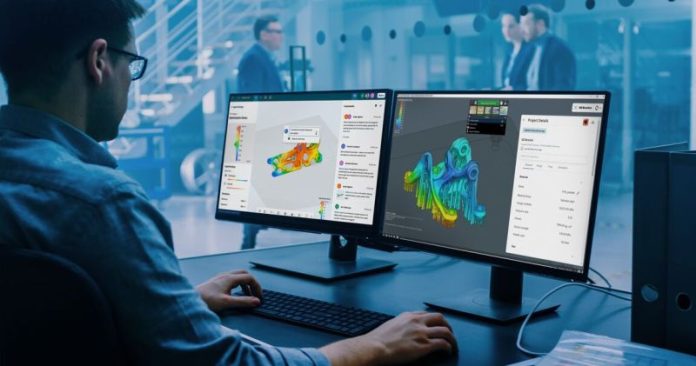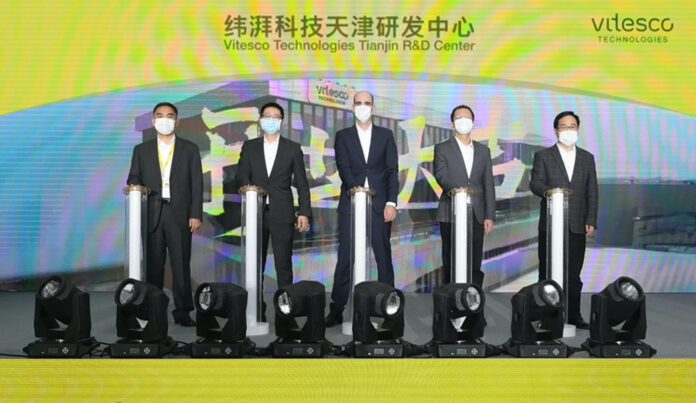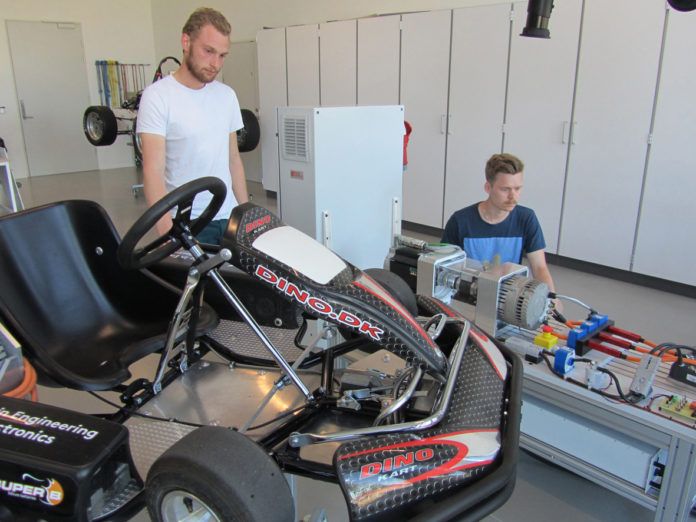A team of researchers of the University of Birmingham is working at the e-Thermal bank, a thermo-chemical system based on microwaves for the climate control of electric vehicles that might extend by even 70% the vehicle’s range.
The system operates as a secondary energy source inside the vehicle, discharging Hvac tasks from the battery and so increasing the autonomy. It acts by coupling a chemical heat pump with the energy of microwaves, supplying heating or conditioning to the cabin on demand, with a higher energy density than battery packs. The microwave energy dissociates a working pair of solid vapour and condenses the vapour into liquid. This charge process stores energy inside the car, inside the e-Thermal bank.
According to researchers, the thermochemical system has a high density of 1600Wh/Kg. On the contrary, the record density for lithium-ion batteries is around 700 Wh/Kg.
“The heating and the cooling of the electric vehicle’s passenger compartment need a notable energy and contribute more significantly in the reduction of the electric vehicle’s range”, affirmed professor Yongliang Li, research manager and holder of the chair of Thermal Energy Engineering at the School of Chemical Engineering in Birmingham.
“We expect that, replacing the conventional Hvac and possibly a small part of the battery pack, e-Thermal banks would provide an efficient control of the cabin’s temperature and a range extension up to 70%, at a lower cost compared to the increase of the battery’s capacity”.
Highlights of microwave Hvac system for electric vehicles
Artificial intelligence for the creation of electric motors
An engineer from DNCL Technologies publicly talks about this hot topic, presenting the last novelties by the Indian company. DNCL Technologies provides Embedded Product Design and development company, DNCL offers Engineering Product Design Services and Industrial Design, Custom Electronics Product Design, IoT product Development PCB Design, Software Design included firmware and software programming services and RTOS services. «We started using an Artificial intelligence design service, and we are thrilled about the potential impacts of AI’s fusion with electric motors. We know that electric motors are a crucial part of many industrial and commercial applications and their efficient operation is essential to maintaining productivity and reducing costs. By implementing anomaly detection, condition monitoring, and predictive maintenance strategies, businesses can ensure that their motors remain in optimal condition, reducing the risk of downtime and costly repairs and extending the lifespan of their equipment».
About anomaly detection, «AI is our motor whisperer, picking up on those subtle cues we may miss. Abnormal vibrations, temperature spikes, unusual power consumption—all signs of underlying problems that left unchecked, could lead to severe damage or motor failure. Condition Monitoring is the round-the-clock guardian, keeping a watchful eye on key performance indicators like temperature, vibration, and power consumption. Machine learning models can detect those slight shifts in motor behaviour, hinting at potential issues».
Predictive Maintenance takes condition monitoring up a notch. By using advanced analytics and machine learning algorithms, AI can predict when maintenance will be needed. Imagine sensors installed in the motor system, collecting data on parameters such as vibration, temperature, current, pressure, and magnetic fields. This data is then processed and analysed to identify anomalies or patterns that could flag potential issues. Finally, by comparing historical motor performance data with real-time sensor readings, predictive maintenance systems can detect anomalies and predict when critical components may fail.
By MIT, an electric 1 MW motor to electrify aviation
The electric motor created by MIT engineers to power even large size aircrafts has the power of 1 megawatt. The motor might also be paired with a conventional jet engine to create a hybrid propulsion system. Until now, in fact, only small full-electric aircrafts have taken off, whereas to electrify larger and heavier jets, like airliners, megawatt motors are needed. The 1-megawatt motor developed by MIT might be a fundamental step towards this direction. For fully electric applications, the team provides the motor can be coupled with a source of electricity such as a battery or a fuel cell. Therefore, the motor could transform the electric energy into mechanical work to power the propellers of an aircraft. The electric machine might also be matched to a conventional turbofan jet engine to operate as hybrid drivetrain, providing electric propulsion during some flight phases. Zoltan Spakovszky, T. A. Wilson Professor of Aeronautics and Astronautics at MIT declared: No matter what we use as an energy carrier (batteries, hydrogen, ammonia, or sustainable aviation fuel) independent of all that, megawatt-class motors will be a key enabler for greening aviation”. The professor added: “This is hard engineering, in terms of co-optimizing individual components and making them compatible with each other while maximizing overall performance. To do this means we have to push the boundaries in materials, manufacturing, thermal management, structures and rotordynamics, and power electronics”. (Picture @Airbus SAS 2023)
Hexagon, virtual prototyping to speed up design
The strategic partnership between the Manufacturing Intelligence division of Hexagon and JSOL Corporation aims at speeding up the virtual prototyping process for the powertrain group of electric vehicles.
“As the move towards electrification accelerates, new challenges need to be addressed to improve vehicle performance characteristics, from the component to system level. For example, improvements to noise, vibration, and harshness (NVH) performance now require simulation solutions to provide answers at much higher frequency ranges. Our partnership with JSOL solidifies our commitment to serve our existing and new customers in this rapidly evolving market”, are the words by Mahesh Kailasam, general manager of design and engineering at Hexagon’s Manufacturing Intelligence division.
“The electrification acceleration in various sectors, like the one of aerospace transports and of automotive, needs the use of simulation technologies to foresee with precision factors such as noise and vibrations, efficiency, duration and thermal management. This solution should be able to capture multi-physical effects in terms of component, subsystem and system.
Another challenge it is possible to win through the simulation is the creation of very light, efficient and innovative electromagnetic thrusters. “Hexagon and JSOL supply engineers with digital platforms and virtual environments that facilitate the development of sophisticated technologies of electric propulsion”, companies add in a press release.
Non-conventional design of concentrated windings
Thanks to appropriate numerical optimisation techniques, it is possible to drastically reduce the losses that originate in permanent magnets due to eddy currents, with a small reduction in the torque that can be developed by the machine. In the same way, it is possible to design machines with concentrated windings with combinations of number of slots and poles traditionally considered incompatible or not feasible in symmetrical form. This is confirmed by the studies carried out by Professor Alberto Tessarolo, University of Trieste, and by examples of how this approach can be of great application interest.
by Gianandrea Mazzola in collaboration with Professor Alberto Tessarolo,
University of Trieste

In the construction technology of modern electrical machines, the use of so-called “concentrated” or “wound tooth” stator windings is becoming more and more frequent, replacing, where possible, the more traditional “distributed” windings. The difference between the two types of windings can be appreciated by the examples shown in figure 1. It will be observed that the distributed winding consists of “ample” coils which embrace a relatively large portion and connect leads arranged in “distant” slots (figure 1a). Conversely, concentrated windings consist of “tooth coils”, i.e. coils each wound around a tooth in the stator’s magnetic core (figure 1b and figure 1c).
A drawback of concentrated windings is the fact that they, even when supplied with ideal currents, produce harmonic fields at the machine air gap which are capable of inducing losses due to eddy currents in permanent magnets and consequent overheating.
Moreover, it is not always possible to opt for concentrated windings. This is possible, in fact, at the state of the art, only for motors and permanent magnet generators in which the number of slots, indicated by Z, is similar (a little higher or a little lower) to the number of poles P.
In general, concentrated windings are usually considered feasible only if the number of slots Z and the number of poles P satisfy a precise algebraic relationship. More precisely, for the feasibility of winding, the quantity K, as shown in the following relation:

must be an integer number, having indicated by MCD (Z, P/2) the Maximum Common Divisor between Z and P/2. The above relation restricts the choice of the number of slots Z and poles P to a limited number of combinations (which we can define as “conventional combinations”). The limitation in question becomes particularly restrictive in the case of windings with more than three phases (m>3), as is often required to increase reliability. In the case of multi-phase windings, the scope of permissible poly-slot combinations is significantly reduced, thus significantly limiting the designer’s choice and precluding, in some cases, the adoption of wound tooth technology.
Large reduction of losses in the magnets, with small reduction in torque
In response to these critical issues, Professor Tessarolo has recently developed and proposed a methodology for the optimized design of concentrated windings, using multi-layer configurations.
“Configurations in which – explains Professor Tessarolo – there can be several coils of different phases wound around the same tooth, as exemplified in figure 2, identifiable by different colours depending on the phase to which they belong.
The methodology, which is based on a particular algorithm of quadratic optimization, nevertheless easily implemented in widespread computing environments (such as Matlab), permits reducing some of the drawbacks of concentrated winding machines.
“In particular – observes Professor Tessarolo – this methodology makes it possible to reduce the risk of overheating of the magnets due to harmonic fields at the air gap and the problem of the limited number of combinations of project-acceptable poly-slots, especially in the case of a number of phases greater than 3.
With regard to the reduction of ohmic losses in magnets, a multi-layer configuration optimized for wound tooth winding makes it possible to reduce the losses in magnets by up to 50%, at the price of a relatively limited reduction in the power developed by the machine. The potential for design optimization is exemplified in figure 3 for the combinations of 9 slots-8 poles and 12 slots-10 poles. The torque and losses of the magnets are normalized with respect to the value they assume for the traditional configuration (with a single coil for each tooth), represented by points A and C. Each point represents an optimized multi-layer design configuration.
“For example, in configuration B for the 9/8 machine, losses are reduced by about 50% at the expense of a 6% reduction in the nominal torque,” says Professor Tessarolo. “In the D configuration for the 12/10 machine, the losses in the magnets can be reduced by about 70% at the price of a drop of only 4% in the nominal torque.”
The optimization also extends the field of acceptable poly-slot combinations
The proposed optimisation method also permits extending the range of possible poly-slot combinations.
“In other words – underlines Professor Tessarolo – the method provides a symmetrical multi-layer configuration for a concentrated winding with a generic number of Z slots and P poles, even if Z and P are not such as to give a whole K in the above-mentioned equation”.
For example, figure 4 shows the cross-section of an 8-slot, 6-pole (unconventional) machine compared to the conventional 9-slot, 6-pole machine; similarly, the cross-section of an 11-slot, 10-pole (unconventional) machine is compared to the conventional 12-slot, 10-pole machine.

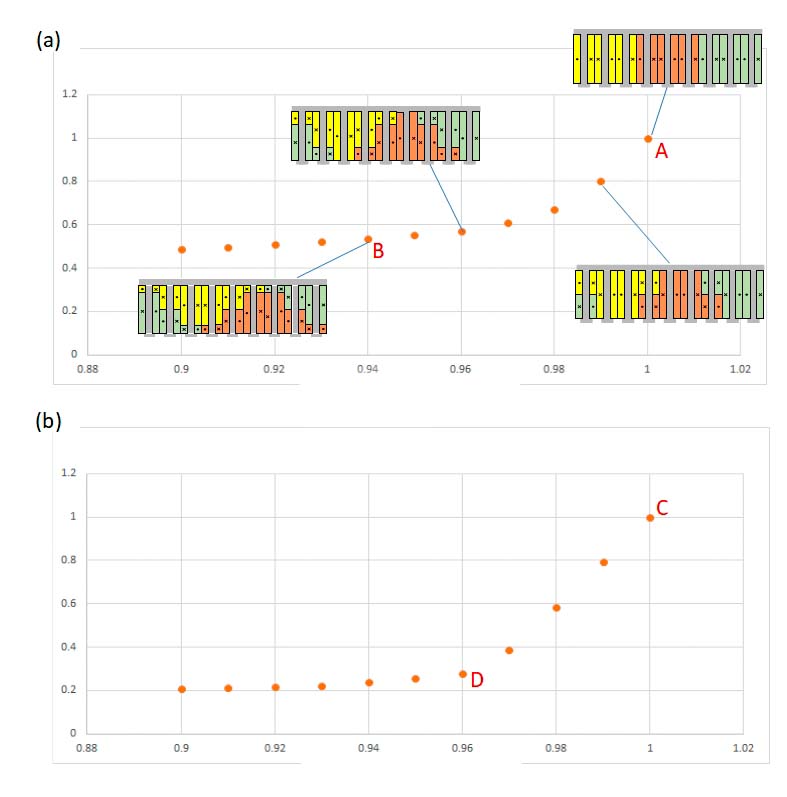
“From the comparison between conventional and non-conventional configurations – says Professor Tessarolo – it appears that the latter, in the face of a greater construction complication, in some cases show better performance. For example, the 9-slot and 6-pole machine in figure 4 has a high torque ripple which is about double that of the 8-slot and 6-pole machine. Or, to quote another example, the 11-slot and 10-pole machine has permanent-magnet losses around half those of the 12-slot and 10-pole machine”.

To give a more complete idea, the tables in figure 5 show a comparison between conventional (white cells) and non-conventional (grey cells) configurations in terms of winding factor and specific losses produced in the permanent magnets. It can be observed that some unconventional configurations have interesting and competitive values.

Operating benefits also for multi-phase machines
The possibility of using unconventional configurations can be particularly useful when designing multi-phase machines or machines consisting of several three-phase windings. This circumstance often occurs in applications that require continuity of service even in the event of a fault.
“For example – comments Professor Tessarolo – if you wanted to build a 12-phase machine, or with double three-phase winding, with eight poles, the conventional rules available in literature would force you to choose, to obtain a whole K from the above-mentioned report, a minimum number of 24 slots. It is clear that, for small machines, the use of Z equal to 24 could lead to unacceptable slot dimensions. The use of an optimized and unconventional multi-layer configuration can, in this case, be of help, making it possible to create a three-phase 8-pole, 9-slot double triad machine, as shown in figure 2”.
The prototype of this machine was also tested, recording the vacuum induced electromotive forces and then verifying the perfect electrical symmetry of the 9-phase winding, as shown in figure 6.
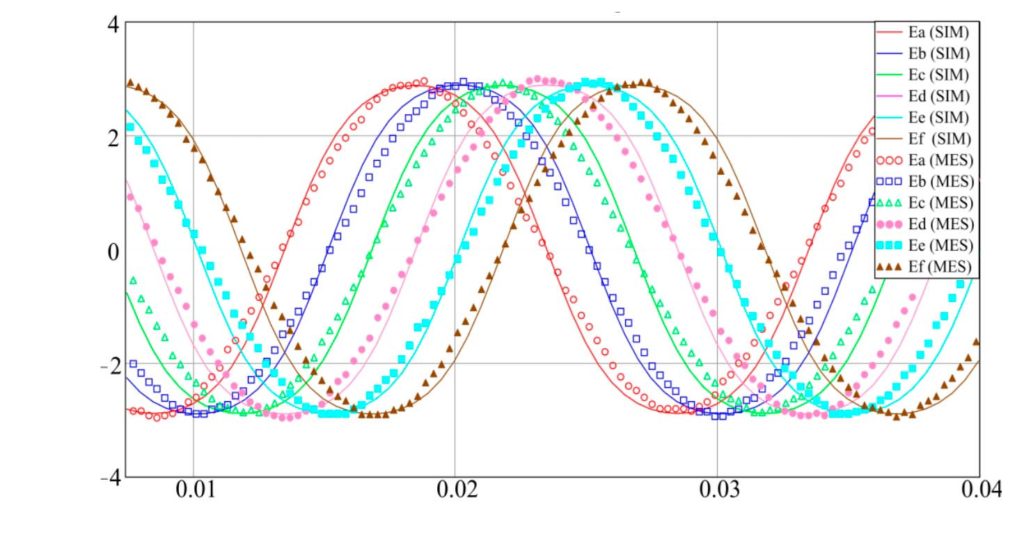
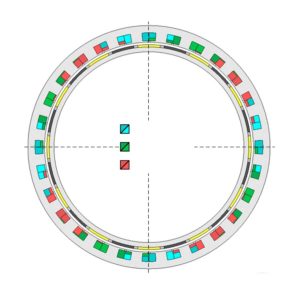
A further example of application is the 12-phase motor shown in figure 7, consisting of four three-phase windings offset by 90 degrees, each characterized by 7 slots and 6 poles. The choice of an unconventional winding in the case of what is shown in figure 7, was dictated by the need to have (for the maximum frequency allowed and the nominal speed) a total number of 24 poles, to be divided between the 4 independent units, of which the machine must consist for fault tolerance reasons. This resulted, for each unit, in a maximum number of 6 poles.
“The choice of 2 and 4 poles – underlines Professor Tessaroli – was not possible, as it led to excessive stator and rotor yoke thicknesses, such as to exceed the design dimensional constraints imposed on the radial dimensions. In this case, the project concerned the development of an electric outboard motor with integrated propeller, where space constraints were predominant. The number of poles for each unit was therefore fixed at 6, the choice of the number of slots such as to give an acceptable winding factor was between Z=9, Z=8 and Z=5, as shown in figure 5”.
The first (conventional) one was rejected because the torque ripple was too high. The only remaining options were therefore unconventional, i.e. 8 slots and 6 poles or 7 slots and 6 poles. The second was chosen because of its lower magnet losses and the almost zero torque ripple.
A prototype of the 7×4 slot and 6×4 pole three-phase quadruple winding machine was made (figure 8 a-b) and this was tested by connecting in parallel 2 of the 4 stator units and loading them respectively on a resistor star and on a diode rectifier bridge (figure 8 c-d). The results of the tests are shown in figure 9, where the waveforms recorded on the test bench are compared with those obtained by simulation of the machine with the finite element method in the time domain.
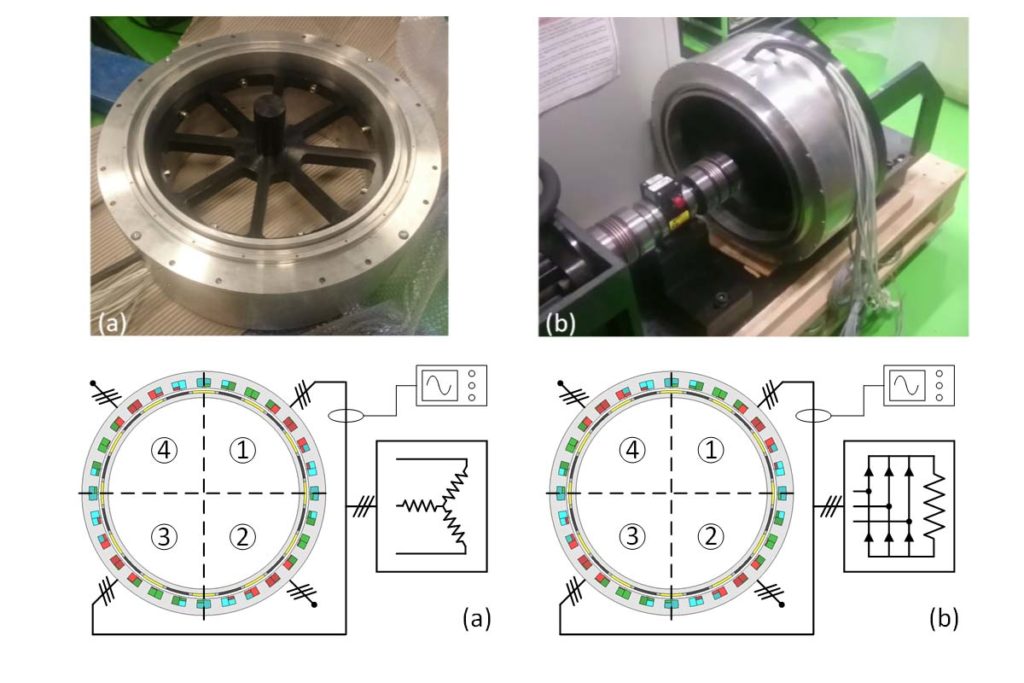
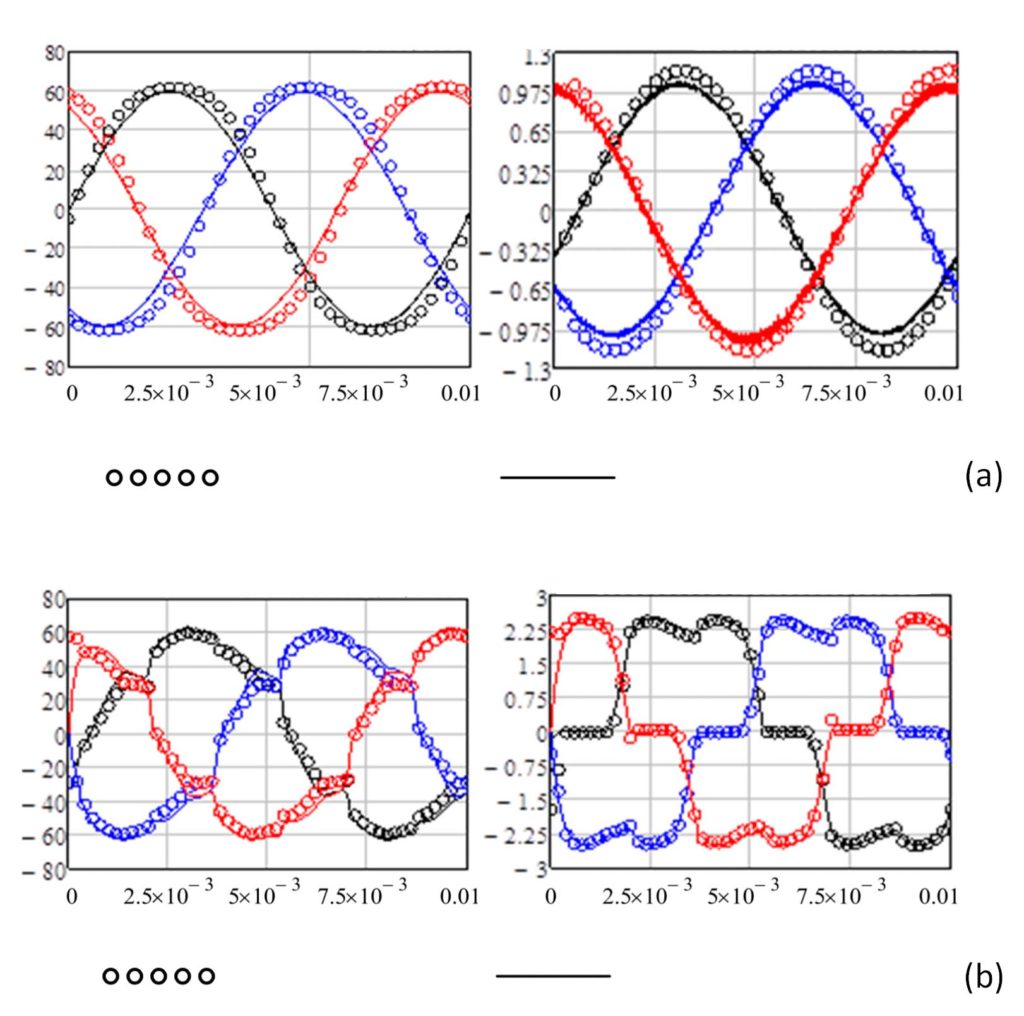
The results confirm the perfect symmetry of the machine and the excellent agreement between design forecasts and experimental behaviour. Similar waveforms, which do not show any unexpected phenomenon as a consequence of the choice of an unconventional winding, were also obtained by loading the other two machine units.
Professor Tessarolo concludes: “It can be said that the realization of concentrated electric windings, beyond traditional shapes and the classical limitations assumed for your project, have wide margins of optimization and extension. Provided that they are implemented on a multi-layer basis”.
It has been shown in these pages how, with appropriate numerical optimization techniques and the operating methodology proposed by Professor Tessarolo, it is possible to drastically reduce (even by more than 50%) the losses that originate in the permanent magnets due to eddy currents, with a small reduction in the torque which the machine is able to develop. It was also shown that, through similar optimization techniques, it is possible to design machines with concentrated windings with combinations of number of slots and poles traditionally considered incompatible or not feasible in symmetrical form. Finally, some application examples have been illustrated of how this can be of interest, especially (but not only) in the design of concentrated winding machines with more than three phases. It is therefore an operational approach and a methodology that, in fact, provides useful elements for greater freedom in design and execution.
Vitesco focuses more on Asia-Pacific region
Vitesco Technologies has inaugurated its new research and development center in Tianjin, China. From there, the company, a top player supplier of advanced powertrain technologies and e-mobility solutions, will increasingly serve the Asia-Pacific region with hybrid and electrified powertrain technologies to meet the rapidly growing e-mobility market. The new research and development (R&D) center have a gross floor area of 9,000 square meters and provides space for around 500 employees.
«Tianjin – said Andreas Wolf, CEO of Vitesco Technologies – is one of our most important locations in China, the world’s largest automotive market. With this new research and development center, we are expanding our capacities precisely where we expect the greatest growth in e-mobility».
Headquartered in Regensburg, Germany, in Tianjin Vitesco Technologies develops battery, motor and electronic control systems for battery electric, full hybrid and 48 V mild hybrid vehicles. The portfolio includes high-voltage drive systems, high-voltage control systems, high-voltage battery management systems, electrified 48 V drive systems and 48 V battery systems. In addition, the R&D center has a versatile laboratory for testing and validation.
The research and development center is located at the Vitesco Technologies Tianjin manufacturing site, which has been there for 26 years. Since 2019, the plant has been producing fully integrated electric axle drives (EMR3) for various customers, including PSA or Hyundai.
Forefront laboratories for the research on electric motors will be set up in Modena
And in this future, the former Foundries in Modena are today at the core of an important redevelopment project that aims at implementing an enormous “innovation hub”, where electric motors will play a central role. Giovanni Franceschini, professor at the Engineering Faculty and already Dean of Unimore Engineering School, has explained the topicality of this area standing out for its great potentialities. «As president of the technical-scientific Committee of Democenter, my missions include seizing the technological challenge represented by the green mobility. So, the National Centre for the sustainable mobility, financed with NRRP resources, was born. Modena is involved in three specific ambits: the first concerns connectivity and autonomous-drive cars, of which Modena is national coordinator, the other two are linked with innovative propulsion, biofuels, hydrogen, fuel cells and electric traction: batteries, inverters and electric motors. The NRRP funds the purchase of equipment to create laboratories and to provide development systems. The idea is to succeed in making a part of the former Foundries a place where implementing these innovative laboratories for the sustainable mobility».
These spaces with academic propensity would represent an excellent opportunity for start-ups and spin offs. Moreover, the whole tertiary training might be moved here. With Democenter, for instance, we have recently started a master dedicated to companies’ employees with “more classic” mechanical education who need to learn how to operate in the new more electric world.
An electric vehicle helipad is coming to downtown Manhattan
The major of New York Eric Adams, the president and managing director of the New York City Economic Development Corporation (NYCEDC) Andrew Kimball have recently taken the first steps to implement a hub unique of its kind for sustainable transports and deliveries. It is a helipad in New York, precisely downtown Manhattan (DMH).
This opens the possibility of electric taxis for the transport of passengers from the airport to downtown and of electric drones also for home deliveries. It seems that in less than two years, through drones, it will be possible to decrease the urban traffic and to halve travel times, with the target of reducing the atmospheric pollution. Just think that it would take only 7 minutes to reach Manhattan downtown from the JFK airport in New York. This direction is pursued by United States startups such as Joby Aviation and Volocopter that have started tests for flying taxis for passengers’ transport.
Test benches for engineering students to asses industrial electronic equipment
The University of Southern Denmark gives young engineering students an opportunity to be part of developing the green technology of the future in a creative study environment with modern teaching facilities and dedicated teachers.
The engineering students are taught electronics and challenged with real-life industrial equipment driven by electric motors and drives manufactured by Nidec.
As part of the teaching projects, the institute and the students have access to several advanced electronic test benches, which gives them a good insight into the handling, testing and research of different combinations of industrial electronic equipment and teaches them to test torque, speed, load, etc. under realistic conditions.
The test benches use Nidec Leroy-Somer motor units (servo motors, LSMV and IMfinity induction ranges) and Control Techniques Unidrive M600/M700 drives and combine different set-ups of advanced variable speed drives and high-tech electric motors, which have the flexibility to test a wide variety of electronic equipment.
Each semester, the electronic engineering degree programme includes project work on a current topic, for example how to design the electronic controller of an electric go-kart motor.
In connection with the project, the students have access to a genuine go-kart with an electric motor as well as a corresponding test bench with programmable drives and electric motors.
Volvo invests in a new laboratory in Shanghai
To design and to manufacture in-house electric motors for the next car generation, Volvo Cars has inaugurated in Shanghai, in China, a new laboratory precisely dedicated to electric propulsion systems. This structure, in operation since last month, joins the unit that constantly develops electric motors in Gothenburg, Sweden, and modern laboratories for batteries in China and Sweden.
«Through in-house design and development processes, we will be able to perfect our electric motors, reaching higher and higher qualitative levels. Constantly ameliorating the overall performance levels of propulsion systems in terms of energy efficiency and comfort, we create an electric drive experience that exclusively identifies Volvo brand» – stated Henrik Green, Chief Technology Officer of Volvo Cars.
The laboratory activity will focus on the development of electric motors for applications in purely electric and hybrid cars based on the modular architecture for SPA 2 vehicles. The future of the brand is well outlined: the target is rising to 50% the share of fully electric models out of the total of global sales by 2025, with the remaining part constituted by hybrid models.




